Horse Chestnut Tree: Leaves, Flowers, Bark (Pictures) – Identification
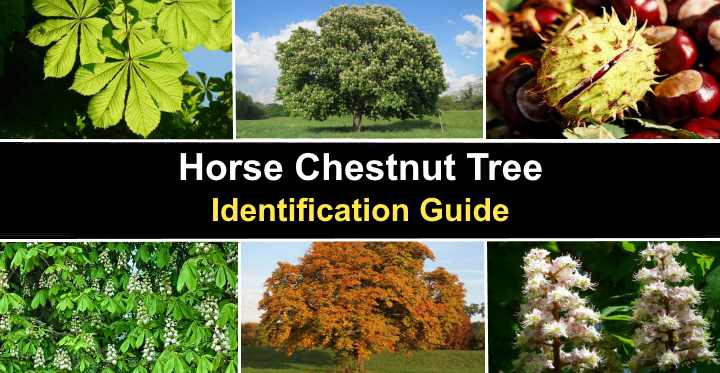
Horse chestnut is a large deciduous tree with spiky green balls containing a large, oval brown seed like the nuts (seeds) from a buckeye tree. A horse chestnut tree is easy to identify in the landscape due to its large, rounded leaves, white-pinkish flowers growing in conical clusters, domed crown, and tall stature. Although too large for most gardens, horse chestnut trees are popular in parks and streets.
This article is a guide to identifying the magnificent horse chestnut tree. Descriptions and pictures of the horse chestnut tree’s leaves, flowers, and fruit will help you recognize these large trees in a landscape.
What is a Horse Chestnut Tree?
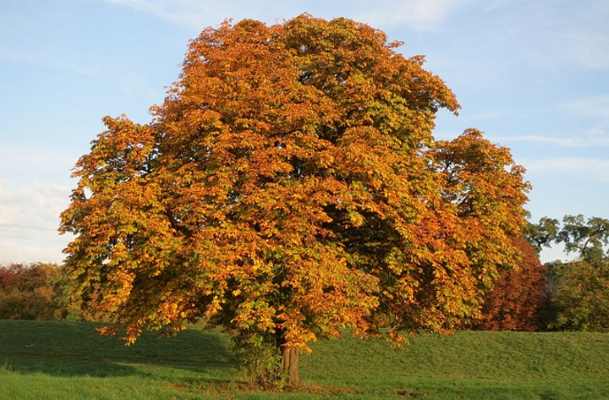
Horse chestnut is a flowering deciduous tree commonly found in parks and open landscapes. In the picture: horse chestnut tree in autumn
The horse chestnut (botanical name Aesculus hippocastanum) is a species of flowering tree in the genus Aesculus. With its stout branches and oval to rounded crown, the tree grows 50 to 70 ft. (15 – 21 m) tall and up to 65 ft. (19 m) wide. However, some horse chestnuts can grow up to 130 ft. (39 m) high.
Horse chestnut trees are native to southeastern Europe and Asia. However, the ornamental tree grows well in colder, temperate regions. It is widely distributed throughout North America in residential parks and city streets. In addition, the horse chestnut’s spreading canopy makes it an ideal shade tree in a large park or open landscape.
The horse chestnut is most famous for its inedible seeds (horse chestnuts)—medium glossy brown nut-like fruits encased in a spiked green shell. In the United Kingdom, the seeds are known as conkers, and the tree is called the conker tree. In the US, the horse chestnut closely resembles the buckeye tree (Aesculus glabra) because they are from the same genus.
Horse chestnut trees have a medium growth rate, averaging 13” to 24” (33 – 60 cm) per year. The deciduous flowering tree thrives in full sun to partial shade and well-drained soil. The hardy tree is suitable for growing in USDA zones 3 through 8.
Can You Eat Horse Chestnuts?
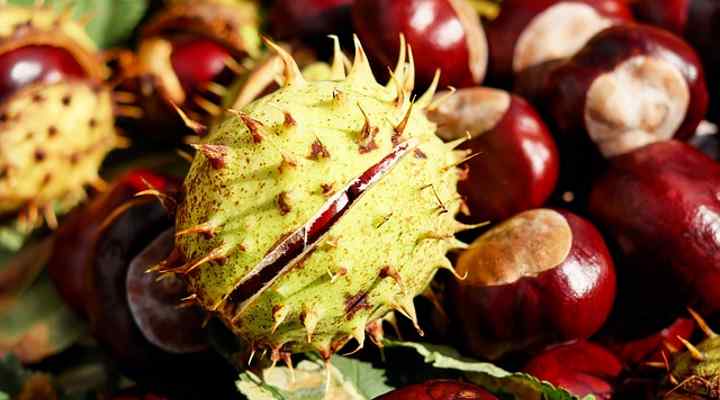
Horse chestnuts (in the picture) are toxic and inedible
Horse chestnuts are not edible because they contain toxic compounds that can cause stomach upset if eaten in large quantities. Eating horse chestnuts is unlikely to be fatal, but the results aren’t pleasant. The fleshy brown seeds are also toxic to animals, including dogs and horses.
However, the round brown horse chestnuts with their creamy-white flesh are a tasty treat for deer. So, if you want to prevent deer from invading your yard in the fall and winter, it’s best to remove all fallen horse chestnut seeds from the ground.
Horse Chestnut vs. Chestnut

Edible chestnut fruit (in the picture) has pointed tip unlike the rounded inedible horse chestnuts
Horse chestnuts are easy to distinguish from unrelated sweet, edible chestnuts (Castanea). Horse chestnuts look like warty, green balls sparsely covered in sharp spikes. Inside is a rounded brown nut with a cream-colored scar. Edible chestnuts are sharp, spiny burrs encasing several oval seeds with a flattened side and pointed end.
The only resemblance inedible horse chestnuts have to sweet chestnuts is the color of the seeds. Edible chestnuts are tightly packed, with up to seven in a spiny husk. The sweet taste of roasted chestnuts comes from the curing and drying process.
The primary way to tell sweet chestnuts apart from horse chestnuts is by their pointed tip. Horse chestnuts are always oval or round without a noticeable apex or tapering end.
Horse Chestnut vs. Buckeye
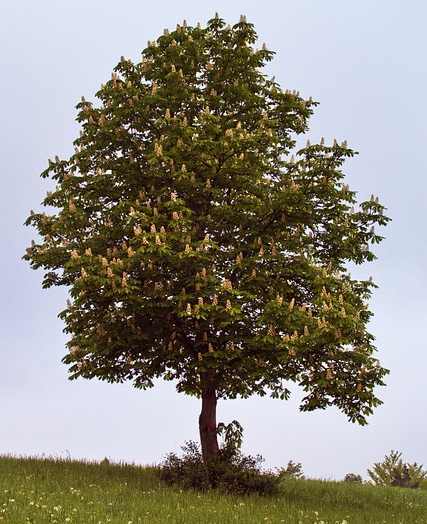
Buckeye tree (in the picture) is smaller than horse chestnut tree and grows between 12 and 40 ft. (3.5 – 12 m) tall
The seeds or nuts from the horse chestnut tree and the buckeye tree are similar but not identical. The seeds from both species are brown, round to oval, with a sheen and whitish oval scar on one end. However, compared to buckeyes, horse chestnuts are the larger variety.
A few identification traits make it possible to differentiate between a buckeye and a horse chestnut tree in the landscape. First, horse chestnut leaves are tear-shaped, with the tapered end at the stem and slightly pointed tip. Buckeye tree leaves are lance-shaped with a pointed apex.
The leaves on both trees are classified as palmately compound, meaning five to seven leaflets grow on a long stem.
Also, compared to horse chestnut seed, buckeye nuts have a glossier appearance.
Horse Chestnut Leaves
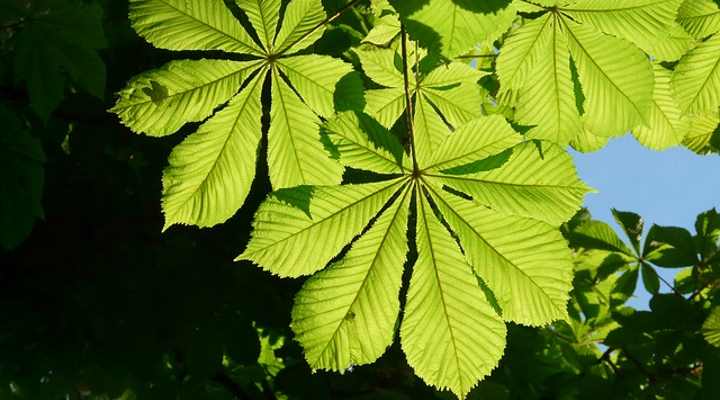
Horse chestnut leaves
Horse chestnut trees have light to dark green palmately compound leaves that have seven obovate leaflets with a slightly pointed tip, and gently tapering to form a narrow base at the stem. The large leaflets measure 4” to 10” (10 – 25 cm) long and grow on long petioles (stems).
Looking at pictures of horse chestnut leaves, you’ll notice their characteristic serrated margins and prominent central midrib and parallel veins. Although having a rounded appearance, horse chestnut leaves have a short, pointed apex.
Horse chestnut leaves emerge light green in early spring, and the tree is one of the first to leaf out in the landscape. The palmate compound leaves gradually turn dark green before turning golden yellow or bronze-brown in the fall.
Horse Chestnut Flower
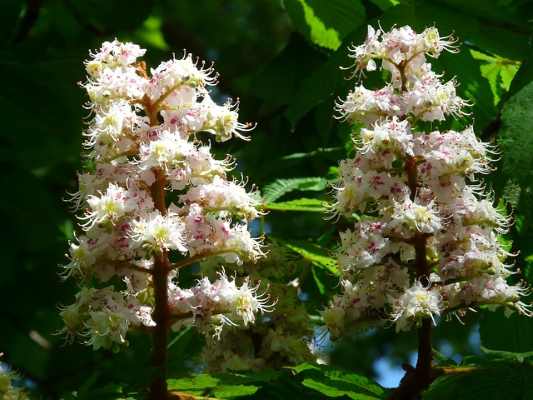
Horse chestnut flowers
Horse chestnut trees have spring flowering white-pinkish flowers that grow in upright triangular panicles (clusters) at the ends of branches. Each individual horse chestnut flower has four or five fused white petals with a pink or orange base. Each pyramidal cluster grows between 5” and 12” (10 – 30 cm) tall.
When in bloom during mid-spring and early summer, the upward growing flowering horse chestnut terminal clusters look like candles on the tree. The distinctive showy flowers in a pyramidal shape make horse chestnuts easily identifiable.
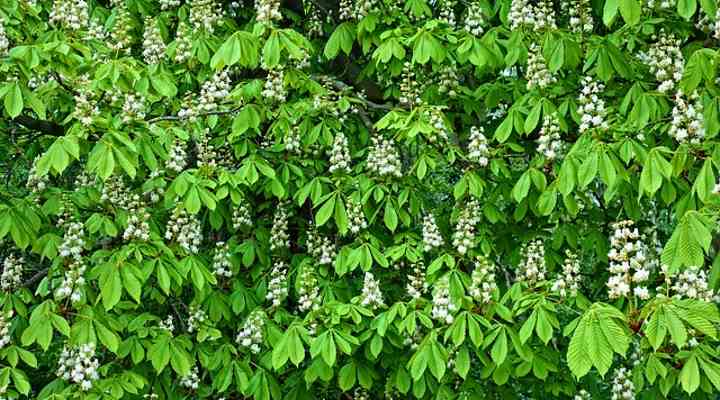
Horse chestnut leaves and flowers
After the flowers fade, the flowers develop into the characteristic horse chestnut fruits.
Horse Chestnut Fruit
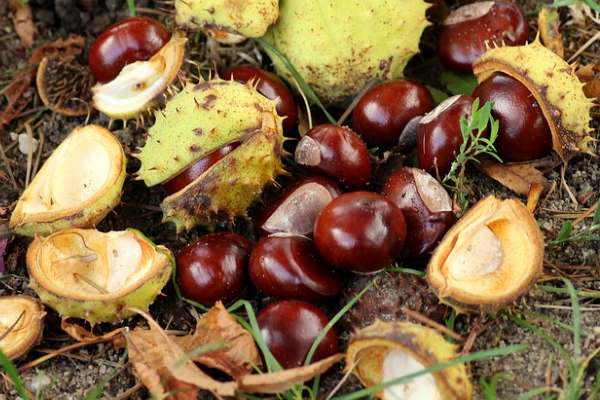
Horse chestnut fruit
Fruit from the horse chestnut tree looks like a spiky green ball dangling in clusters from the ends of branches. As the spiked round fruits mature, the green casing develops brown speckles before dropping in the fall. Finally, the soft, thick husk opens, revealing a shiny mahogany brown nut with a creamy white oval scar.
The horse chestnut fruit, along with the leathery husk, can measure up to 3” (7.5 cm) in diameter. The husk splits as the fruit matures, revealing one or two horse chestnuts or conkers. The inedible brown ‘nuts’ from a horse chestnut measure 1” to 2” (2.5 – 5 cm) across.
Horse Chestnut Bark

Horse chestnut bark
Bark on the horse chestnut tree is a grayish-green color that is smooth and gradually develops fissured scales. As the tree matures, the trunk develops a distinctive fluted shape, making it look like thick, fused trunks growing together.
Horse Chestnut Tree Identification
Identify a horse chestnut tree by its large palmate leaves, upward growing triangular clusters of flowers, and spiky green fruit. The distinctive horse chestnut fruit is green, with sharp spines covering the round seed pod. Other easily identifiable features are the horse chestnut’s candle-like flowers and drooping obovate leaves.
Types of Horse Chestnut Trees (Pictures) – Identification
There are two primary varieties of horse chestnut trees, Aesculus hippocastanum and the red horse chestnut tree Aesculus carnea.
Horse Chestnut Tree (Aesculus hippocastanum)
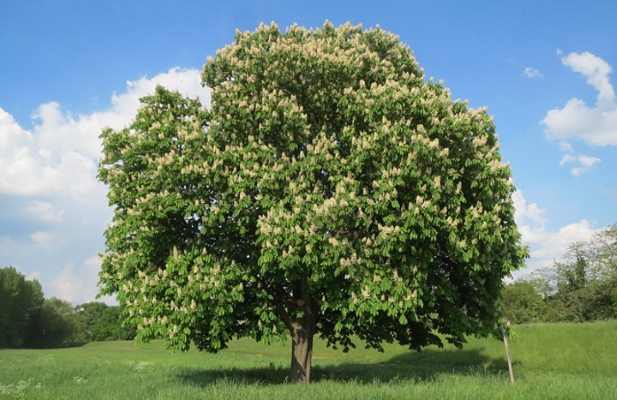
Horse chestnut tree (Aesculus hippocastanum)
The horse chestnut tree is a sizable ornamental landscape tree with clusters of white flowers, sizable prickly seed pods, and huge leaves. The large deciduous tree typically grows around 75 ft. (22 m) tall, with a large, oval crown spreading up to 65 ft. (19 m) wide.
Horse chestnuts grow in USDA zones 3 through 8. The large landscape tree thrives in most soil types if there is excellent drainage. The impressive shade tree performs well in full sun to part shade and is characterized by showy flowers and spiky seed capsules.
Horse Chestnut Leaves: Leaves on a horse chestnut are easy to identify due to the large, rounded teardrop-shaped leaflets with serrated margins growing five to seven on a stem.
Horse Chestnut Flowers: Flowers on a horse chestnut bloom in spring and are upward-pointing conical clusters of white flowers with a hint of pink.
Horse Chestnut Bark: The bark on a horse chestnut tree is smooth, light gray when immature, and gradually develops a rough, scaly texture with irregular fissuring.
Horse Chestnut Fruit: The distinctive horse chestnut fruits are spiky green balls with a green leathery husk covering a smooth rounded matte brown nut.
Red Horse Chestnut Tree (Aesculus carnea)

Red horse chestnut tree (Aesculus carnea)
A red horse chestnut tree is identified as an ornamental deciduous tree with conical clusters of attractive red flowers, palmate compound leaves with five leaflets, and small, round spiky seed pods. The red horse chestnut tree grows 30 to 40 ft. (9 – 12 m) tall, and its rounded crown spreads up to 35 ft. (10 m) wide.
The red horse chestnut is a hybrid tree of the Aesculus hippocastanum and Aesculus pavia (red buckeye). The red horse chestnut isn’t as tall as the regular horse chestnut, and it has deep red showy flowers rather than white ones. Also, compared to the typical horse chestnut tree fruit, the spiky green balls on the red variety are smaller.
The red horse chestnut is suitable for growing in USDA zones 5 through 8. Like most species of Aesculus, the leafy flowering tree performs well in full sun or partial shade. The attractive shade tree grows well in most soils that are well-drained. However, for healthy growth, it’s vital to prevent the ground from becoming too dry.
When in bloom from late spring through summer, the beautiful bright rosy-red flowers make a spectacular floral display. The upward pointed flower cones grow abundantly and provide a beautiful contrast with the dark green foliage.
There are a few subtle ways to tell a red horse chestnut apart from a regular one. First, the red variety has leaves that are more pointed rather than rounded. Second, there are typically only five leaflets on the palmate compound leaves of a red horse chestnut tree. Finally, in spring, the red flower clusters easily help to identify a red horse chestnut.
Red Horse Chestnut Leaves: Leaves on the red horse chestnut are lanceolate with tapered ends at the stem and pointed tips. The leaves grow palmately, with five leaflets measuring 4” to 8” (10 – 20 cm) forming a compound leaf.
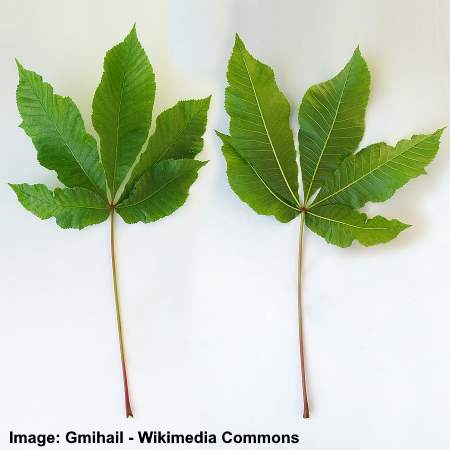
Red horse chestnut leaves
Red Horse Chestnut Flowers: The distinctive red horse chestnut flowers grow in attractive upward pointed conical panicles and have a pretty deep red color. The red, cone-shaped clusters grow up to 8” (20 cm) tall.

Red horse chestnut flowers
Red Horse Chestnut Bark: The bark on the red horse chestnut is primarily gray and smooth. It eventually develops rounded scales separated by shallow fissures giving the light gray bark a rough texture.
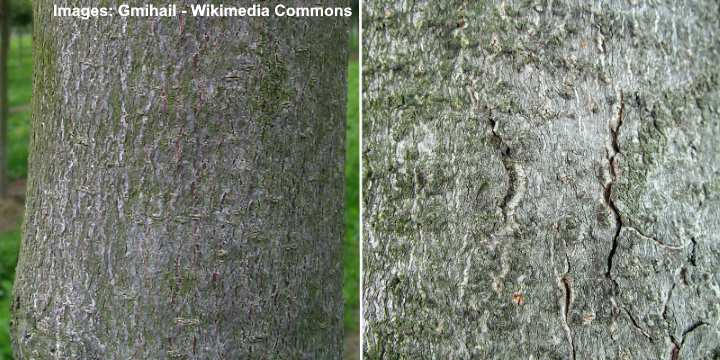
Red horse chestnut bark
Red Horse Chestnut Fruit: The fruit from a red horse chestnut tree is a spiny capsule measuring 1.5” (3.8 cm) in diameter containing a glossy brown inedible seed.
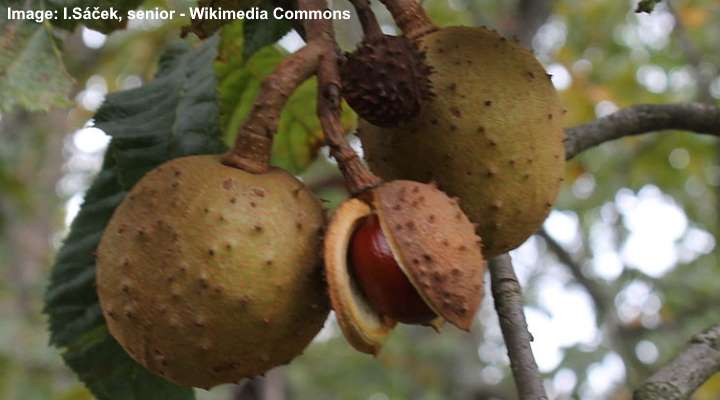
Red horse chestnut fruit
Horse Chestnut Growth Rate
It’s good to remember that horse chestnut trees have a medium growth rate and wide spread. Growing up to 70 ft. (21 m) tall and 60 ft. (18 m) wide means they need enough room to grow. Therefore, the landscape trees are not suitable for small to medium-sized gardens.
If you want to grow an ornamental horse chestnut tree, the red horse chestnut ‘Briotii’ is a smaller cultivar. The medium-sized flowering tree grows 25 – 35 ft. (7 – 10 m) tall. Its rounded crown has lustrous, small leaves and showy dark red flowers. The landscape tree is suitable for growing as a large lawn tree or shade tree.
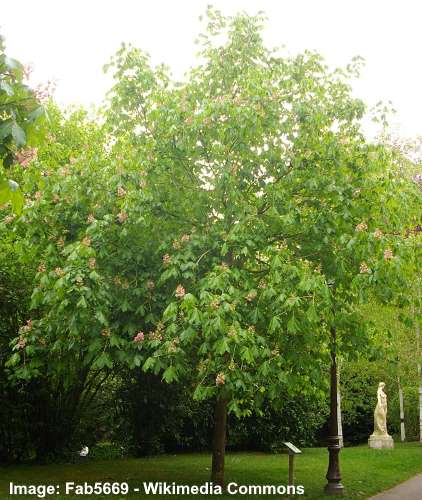
Red horse chestnut ‘Briotii’ ( in the picture) is a smaller cultivar of horse chestnut tree
How to Grow Horse Chestnut Tree
Horse chestnut trees grow best when grown in full sun or partial shade. The hardy trees thrive in most soil types—loamy, sandy, acidic, or alkaline. The soil should be kept moist without being too soggy. To encourage healthy growth, adding fertilizer in the spring can boost soil nutrient levels.
Pruning Horse Chestnut Trees
Pruning a horse chestnut tree every fall is a good idea if you have one growing in your backyard. You should trim off crossing or crowding branches and remove low-growing branches if necessary. You can prune branches every four or five years with older, mature trees to maintain their shape.
Horse Chestnut Seed Propagation – How to Plant Horse Chestnuts Conkers
Horse chestnut trees are easy to propagate from the large round brown seeds. To germinate horse chestnut seeds (conkers), gather some seeds in the fall. Put the seeds in a jar of water and discard any that float.
Next, put the seeds that sink in a pot filled with moist potting soil and plant them 2” (5 cm) deep before the weather gets cold. Place the pot in a sheltered spot, protected from hard frosts. The seeds need a few months where the temperature is below 50°F (10°C) to germinate. Keep the soil slightly moist but not overly damp.
If the pots are outside, it’s also necessary to protect them from deer that like to forage for food during winter.
When seedlings are at least 1 ft. (0.3 m) tall, you can transplant them to the ground.
Pests and Diseases Affecting Horse Chestnut Growth
The horse chestnut leaf miner and leaf blotch fungus are the two primary issues affecting the trees.
A small brown furry moth (Cameraria ohridella) lays its eggs inside the horse chestnut tree leaves. When the larvae appear, the caterpillars feed on the plant tissue, causing unsightly brown blotches to appear on the leaves. A large leaf-mining moth infestation can turn most leaves brown, making the foliage appear as if fall has come early.
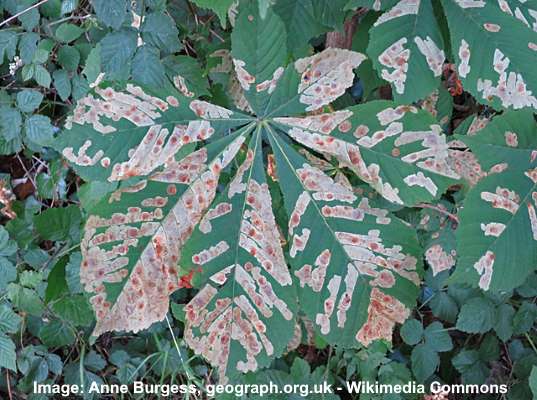
Horse chestnut leaf miner
A fungal disease—Guignardia aesculi—can cause leaf blotch on horse chestnut trees. The disease causes yellowish-brown blotches to develop. Although the fungal infection won’t kill the tree, it can give the tree a sickly appearance.
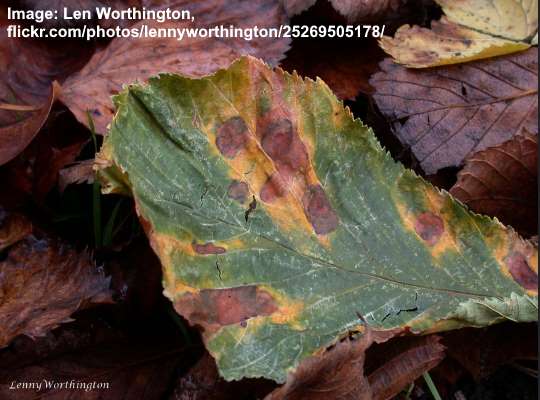
Guignardia aesculi on horse chestnut
A more serious disease affecting the health of horse chestnut trees is bleeding canker caused by the bacterium Pseudomonas syringae pathovar aesculi. The signs of the potentially fatal disease include a rust-colored sap that seems to bleed from the tree’s branches and trunk.
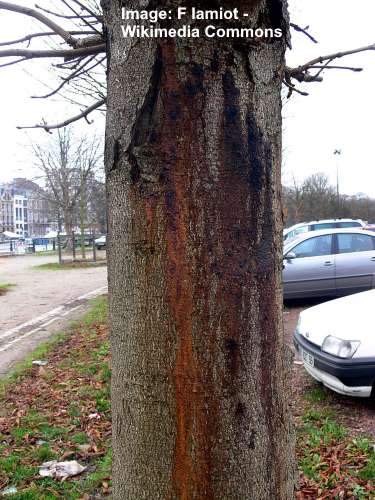
Bleeding canker disease
Related articles:
